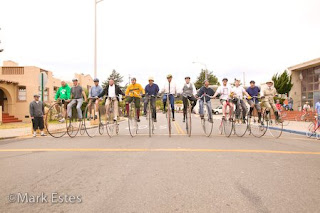Q: I have a Schwinn GS hybrid. It's equipped with what they call a carbon
"flex fork" that has very little rake as compared to my other bikes. I've
had 3 incidents where I got high speed wobble in the 35-40mph range. I
managed to get it whoa'd down before a crash, but it was very scary. I've
never had this problem on any other bike. I've checked the headset, wheels,
bearings, etc. and all seem fine. I've given it a lot of thought and it
seems to happen when I'm leaning to the right or off camber leaning to the
right. The fork looks like it "melted" during the wobble. I'm an old coot,
don't need to have a high speed crash. Got any ideas?
Regards,
Fritz
A:
Hi Fritz,
Speed wobble on bicycles and motorcycles is a fairly common problem so the
first thing is to have a plan for when/if it happens, and one thing you can
do that will usually get the bicycle under control immediately is to stop
pedaling and clamp your knees against the top tube. This will brace the top
tube and should stop the speed wobble right away. This is an old trick but a
good one to know because speed wobble can happen and sometimes even on bikes
that never wobbled before.
Finding the cause of a wobble and eliminating it can be more difficult. You
might start by replacing your wheels with someone else's and going down the
same hill where your bike wobbled and see if it does it with the different
wheels. If not, it might be that the spoke tension of your wheels is too low
or that you have a defective tire with an "S" in the casing from a stone
bruise to the casing.
It can be helpful to get a second opinion, too. If another person can't get
your bike to wobble on the same hill that it just wobbled on for you, you'd
have reason to suspect it could be how your bike is set up to fit you. For
example, if the seat is too high, your weight is too high and that can
affect how a bike handles. It sounds like you checked for the usual culprits
like a loose headset, warped wheels, loose wheel bearings. You might try
tightening your headset a bit. Usually there's a bit of tolerance and you
could try setting it a little tighter than it is and see if that helps damp
the front end and stop the wobble.
Hopefully one of these tips will help you solve the wobble, but I have seen
bikes that just wobbled under certain riders and under certain conditions. I
have a very nice road bike like this in my garage. It wobbles for me on
steep hills so it's reserved for people who weigh less and none have ever
got it to wobble. I believe the tubing in the frame is too light for my 170
pounds and where it's positioned on the bike when I ride it. Put a 160 pound
guy on it and it's fine.
And, I should add that I don't think the carbon fork is the issue. You could
certainly swap out the fork to see if a different one would stop the wobble.
But, my Litespeed has one of the lightest carbon forks made on it, an old
Look HSC, and even though it looks scary flexible on bumpy descents it has
never wobbled.
If you have a good mechanic you could have test ride your bike that would be
a good way to go, too, especially if he can experience the wobble.
Good luck. Let me know if you figure out what's causing it,
Jim
--------------------------------------
Q: Jim - Will a 26 x 2-inch tubeless tire fit properly on a 26 x 1.75 wheel?
Also, what width range of tubeless tire will properly fit a 26 x 1.75 wheel?
Thanks,
Chuck
A: Hi Chuck,
26 x 1.75 is a standard size used on some mountain bikes, so pretty much any
26 inch "mountain-bike" tire will fit, including 26 x 2.0, 1.5, 1.9, 2.3,
etc. Tubeless tires usually come in the wider sizes, though, and any of
those should work fine on your wheel. There are also skinny (not tubeless)
tires meant for road use like 1.25 and even 1 inch that will work, too, as
long as that's a modern wheel you have, and not something very old without
rims that'll hang onto a skinny tire. And, if you go with a skinny road tire
it's best to replace the tube with one that fits, too, otherwise it can be
super hard to mount the tire.
Hope this helps,
Jim
--------------------------------------




